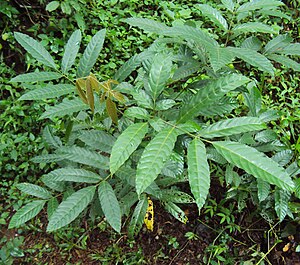Note: This is a project under development. The articles on this wiki are just being initiated and broadly incomplete. You can Help creating new pages.
Leea indica
Leea indica is an erect shrub to small tree, often with several stems. It usually grows up to 10 metres tall, occasionally to 16 metres, with stems around 19cm in diameter. Plants are frequently stilt-rooted. The plant is gathered from the wild for local use as a food and medicine. It is locally cultivated in India and China for medicinal purposes. It is often grown as an ornamental and is also grown as a green manure.
Contents
- 1 Uses
- 2 Parts Used
- 3 Chemical Composition
- 4 Common names
- 5 Properties
- 6 Habit
- 7 Identification
- 8 List of Ayurvedic medicine in which the herb is used
- 9 Where to get the saplings
- 10 Mode of Propagation
- 11 How to plant/cultivate
- 12 Commonly seen growing in areas
- 13 Photo Gallery
- 14 References
- 15 External Links
Uses
Severe cough, Fever, Headache, Body pains, Dizziness, Body pains, Fevers, Sleeplessness, Muscular pain, Leucorrhoea, Intestinal cancer.[1]
Parts Used
Chemical Composition
Common names
| Language | Common name |
|---|---|
| Kannada | Gadhapatri |
| Hindi | Kukur jihwa |
| Malayalam | Nakku |
| Tamil | Nalava |
| Telugu | Amkador |
| Marathi | Karkani |
| Gujarathi | NA |
| Punjabi | NA |
| Kashmiri | NA |
| Sanskrit | Chatri |
| English | Bandicoot berry |
Properties
Reference: Dravya - Substance, Rasa - Taste, Guna - Qualities, Veerya - Potency, Vipaka - Post-digesion effect, Karma - Pharmacological activity, Prabhava - Therepeutics.
Dravya
Rasa
Tikta (Bitter)
Guna
Laghu (Light)
Veerya
Sheeta (cold)
Vipaka
Karma
Pitta
Prabhava
Habit
Identification
Leaf
| Kind | Shape | Feature |
|---|---|---|
| 2-3 pinnate | Alternate | Leaves 2 or 3 pinnate, alternate, leaflets 11-14 x 3-5 cm, oblong or elliptic-lanceolate, apex caudate-acuminate, serrate-dentate; lateral nerves 12-15 pairs, intercostae parallel, curved; stipules obovate-obtuse, to 5 x 4 cm |
Flower
| Type | Size | Color and composition | Stamen | More information |
|---|---|---|---|---|
| Cymes | Terminal cymes | Greenish white | Flowering and fruiting is from March to August |
Fruit
| Type | Size | Mass | Appearance | Seeds | More information |
|---|---|---|---|---|---|
| A berry | 6mm across | Seeds densely red-glandular | {{{6}}} |
Other features
List of Ayurvedic medicine in which the herb is used
Where to get the saplings
Mode of Propagation
Seeds, Cuttings, Air layering.
How to plant/cultivate
Succeeds in full or partial sun, preferring a moist, fertile, well-drained soil.[4]
Commonly seen growing in areas
Swamp forests, Sub-montane forests, Along rivers, On limestone.
Photo Gallery
References
- ↑ Uses of Leea indica - Indian Medicinal Plants by C.P.Khare
- ↑ Vernacular names
- ↑ PLANTS OF KERALA VER.2, N. Sasidharan BOTANIC DESCRIPTION
- ↑ Cultivation
External Links
- Ayurvedic Herbs known to be helpful to treat Severe cough
- Ayurvedic Herbs known to be helpful to treat Fever
- Ayurvedic Herbs known to be helpful to treat Headache
- Ayurvedic Herbs known to be helpful to treat Body pains
- Ayurvedic Herbs known to be helpful to treat Dizziness
- Ayurvedic Herbs known to be helpful to treat Fevers
- Ayurvedic Herbs known to be helpful to treat Sleeplessness
- Ayurvedic Herbs known to be helpful to treat Muscular pain
- Ayurvedic Herbs known to be helpful to treat Leucorrhoea
- Ayurvedic Herbs known to be helpful to treat Intestinal cancer
- Herbs with Young shoots used in medicine
- Herbs with Fruits used in medicine
- Herbs with common name in Kannada
- Herbs with common name in Hindi
- Herbs with common name in Malayalam
- Herbs with common name in Tamil
- Herbs with common name in Telugu
- Herbs with common name in Marathi
- Herbs with common name in Sanskrit
- Herbs with common name in English
- Habit - Shrub
- Index of Plants which can be propagated by Seeds
- Index of Plants which can be propagated by Cuttings
- Index of Plants which can be propagated by Air layering
- Herbs that are commonly seen in the region of Swamp forests
- Herbs that are commonly seen in the region of Sub-montane forests
- Herbs that are commonly seen in the region of Along rivers
- Herbs that are commonly seen in the region of On limestone
- Herbs
- Pages without herbs images







